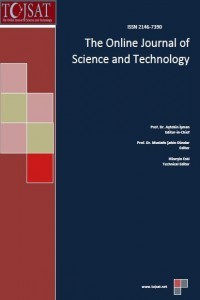Changes of Microbial Population and Some Components in Carrot Juice During Fermentation with Selected Autochthonous Lactobacillus Plantarum Strains
Changes of Microbial Population and Some Components in Carrot Juice During Fermentation with Selected Autochthonous Lactobacillus Plantarum Strains
Lactic acid bacteria, Lb. plantarum, Carrot juice Lactic fermentation,
___
- Andersson, R. 1985. Nitrate reduction during fermentation by gram negative bacterial activity in carrot. Journal of Food Microbiology, 2, 219-225.
- Aubert, S. 1981. La carotte (Daucus carota L), Revue de quelques facteurs d’intérêt diététique. Cahier de Nutrition et Diétetique, 16, 173-186
- Daly, C. Davis, R. 1998. The biotechnology of lactic acid bacteria with emphasis on applications in food safety and human health. Agriculture and Food Science, 7, 251-264.
- Demir, N. Savas Bahçeci, K. Acar, J. 2006. The effects of different initial Lactobacillus plantarum concentrations on some properties of fermented carrot juice. Journal of Food Processing and Preservation, 30, 352-363.
- Fu, W. Mathews, A.P. 1999. Lactic acid production from lactose by Lactobacillus plantarum: Kinetic model and effects of pH, substrate,and oxygen. Biochemistry Engineering Journal, 3, 163–170.
- Gorinstein, S. Zachwieja, Z. Folta, M. Barton, H. Piotrowicz, J. Zemser, M. Weisz, M. Trakhtenberg, S. MartinBellosso, O. 2001. Comparative Contents of Dietary Fiber, Total Phenolics, and Minerals in Persimmons and Apples. Journal of Agriculture and Food Chemistry, 49, 952-957.
- Idoui,T. Karam, N.E. 2008. Lactic acid bacteria from Jijel’s traditional butter: Isolation, identification and major technological traits. International Journal of Fats and Oils, 59, 361-367.
- Karam, N.E. Belarbi, A. 1995. Detection of polygalacturonases and pectin esterases in lactic acid bacteria. World Journal of Microbiology and Biotechnology, 11, 559-563.
- Mc Donald, L.C. Fleming, H.P. Hassan, H.M. 1990. Acid tolerance of Leuconostoc mesenteroides and Lactobacillus plantarum. Applied Environment Microbiology, 56, 2120-2124.
- Passos, F.V. Fleming, H.P. Ollis, D.F. Hassan, H.M. Felder, R.M. 1993. Modelling the specific growth rate of Lactobacillus plantarum in cucumber extracts. Applied of Microbiology and Biotechnology, 40, 143-150.
- Ray, B. Daeschel, M. 1992. Food biopreservatives of microbial. In: Boca Raton, CRC Press Florida.
- Salih, A.G.Drilleau, J.F.1992. Jus de carotte lactofermenté Quel avenir ?. Cahier Scientifique et Technique, 109, 7-9.
- Schobinger, U. 1987. Frucht-und Gemuesesaefte, 2. Auflage. Verlag Eugen Ulmer, Stuttgart, Germany.
- Yabannavar, V.M. Wang, D. I. 1991. Analysis of mass transfer for immobilized cells in an extractive lactic acid fermentation. Biotechnology Bioengineering, 37, 544-550.
- ISSN: 2146-7390
- Başlangıç: 2011
- Yayıncı: The association of science, education and technology
Abdi AKİLA, Benhadj MABROUKA, Alioua SOUAD, Gacemi-kirane DJAMİLA
Performance of Distant Education System in Turkey
Putting Customer in Charge of Design: Opportunities and Challenges
On Horizontal Beams and Sound Radiation due to a Moving Load
Nitin AGARWALA, E M Somashekharan NAİR
Analysis of vegetation assemblage in the salted plain of the lower Chelif, Algeria
A. ABABOU, M. CHOUİEB, A. BOUTHİBA, D. SAİDİ, M. M’hamedi BOUZİNA, K. MEDERBAL
Potency of Aqueous White Grubs Extract Against CCl4 Induced Liver Diseases in Rats
M. S. SULE, A. J. ALHASSAN, Y. ABDULMUMUNİ
